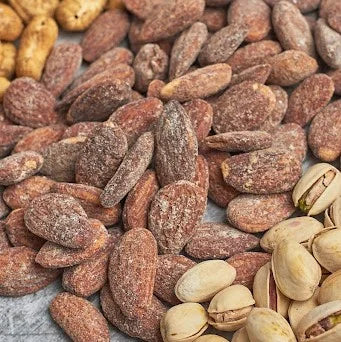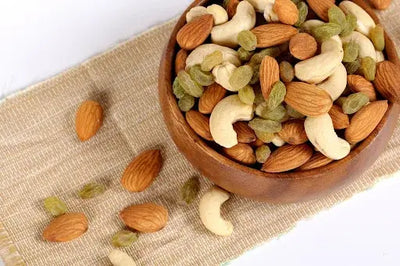Which nutrients are best preserved after roasting?
Roasting nuts can affect their nutritional profile, but many nutrients are well preserved and may even become more bioavailable. In this article, we'll explore the properties of roasted nuts:
Nutrients that are well preserved or improved by roasting
Proteins
The protein content of nuts is barely affected by roasting. Their structure may change slightly, but they remain an excellent source of plant-based protein.
Healthy fats
Although heat can break down some unsaturated fatty acids, roasted nuts still maintain a high content of healthy fats (monounsaturated and polyunsaturated), essential for cardiovascular health.
Minerals (magnesium, phosphorus, potassium, zinc, iron, calcium)
Minerals are heat-stable, so roasting doesn't significantly reduce their content. Nuts remain a great source of these essential micronutrients.
Fiber
Dietary fiber, crucial for digestion and intestinal health, remains intact after roasting.
Nutrients that may be affected
Heat-sensitive vitamins (Vitamin C, some B vitamins)
Vitamin C is almost non-existent in nuts, but some B vitamins, such as B1 (thiamin), can be degraded by heat.
Antioxidants and polyphenols
Some antioxidants may be reduced by roasting, but in certain cases (such as almonds and hazelnuts), the process can enhance the availability of beneficial compounds, such as tocopherols (vitamin E).
What percentage of nutrients is lost in the process?
The percentage of nutrient loss when roasting nuts varies depending on the type of nut, the temperature, and the roasting time.

How does roasting affect natural oils?
Roasting affects the natural oils of nuts mainly in three ways: oxidation, fatty acid structure and flavor/aroma.
1. Oxidation of oils
Nuts contain a high amount of unsaturated fats, which are more susceptible to oxidation when exposed to heat. However, if roasted correctly (at moderate temperatures and without prolonged exposure to oxygen), oxidation is minimal.
- Low-moderate temperatures (120-150°C): Little or no oxidation.
- High temperatures (>160°C) or prolonged times: Greater risk of oxidation and formation of unwanted compounds, which can affect the quality of the product.
2. Changes in the structure of fatty acids
- Monounsaturated fatty acids (such as oleic acid in almonds and hazelnuts): They are quite stable and resist heat well.
- Polyunsaturated fatty acids (like omega-3s in walnuts): They are more sensitive to heat and can be partially degraded.
3. Flavor and aroma
Roasting enhances the flavor by producing Maillard reactions , which generate aromatic compounds and enhance the taste of nuts. It can also cause natural oils to be released more, resulting in a crispier texture and a more intense flavor.
Are there nutritional differences between raw and roasted foods?
Yes, there are some nutritional differences between raw and roasted nuts, although both are generally still highly nutritious.
What antioxidants remain after roasting?
The antioxidants present in nuts may be affected by roasting, but some maintain or even increase their bioavailability.
Antioxidants that remain after roasting:
Polyphenols:
Although they can be partially degraded at very high temperatures, in some nuts (such as almonds and hazelnuts) roasting can increase their bioavailability , making them better absorbed by the body.
Phenolic compounds:
In nuts such as walnuts, almonds and hazelnuts, the levels of these compounds can remain stable or even increase after moderate roasting.
Tocopherols (Vitamin E)
They remain relatively stable in nuts such as almonds and hazelnuts, although they can be reduced if the roasting is very intense.
Antioxidants that can be degraded:
Vitamin C:
It practically disappears with heat, but it is not a relevant antioxidant in nuts.
Carotenoids:
They can be degraded to some extent if roasting is prolonged or at high temperatures.
How does roasting affect the preservation of nuts?
He Roasting affects the preservation of nuts in several ways, both positive and negative:
Benefits of roasting in conservation:
✅ Lower moisture content → Heat reduces the moisture content of the dried fruit, making it difficult for fungi and bacteria to grow, increasing its shelf life.
✅ Greater microbiological stability → Heat destroys microorganisms present on the surface.
✅ Greater flavor intensity and crunchy texture → Can make nuts more appealing to the consumer and less likely to become soft over time.
Disadvantages of roasting in conservation:
❌ Greater susceptibility to rancidity → Natural oils are more exposed to oxygen, which accelerates oxidation and rancidity, especially in nuts rich in unsaturated fats, such as walnuts.
❌ Loss of protective antioxidants → Some antioxidants that protect natural oils can degrade, increasing the possibility of oxidation.
❌ Greater sensitivity to light and air → Without the natural protective layer of the skin, the oils in nuts like almonds or hazelnuts oxidize more quickly.
Recommendations to improve the conservation of roasted nuts:
We invite you to read our article on " How to Keep Your Nuts in Perfect Condition " to enjoy your nuts at their peak condition from the first to the last. In any case, here are some basic tips to keep in mind:
- Store in airtight containers to reduce contact with oxygen.
- Avoid exposure to light and heat to delay oxidation.
- Prefer opaque or vacuum-sealed containers to maintain freshness for longer.
- Store in a cool, dry place, or even in the refrigerator.






Leave a comment
This site is protected by hCaptcha and the hCaptcha Privacy Policy and Terms of Service apply.